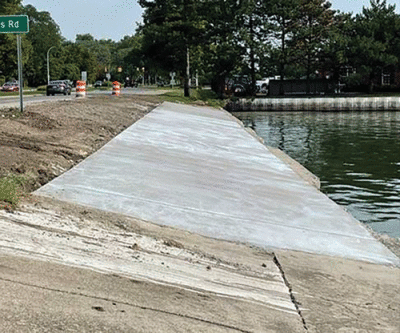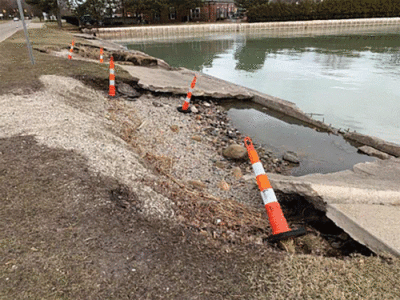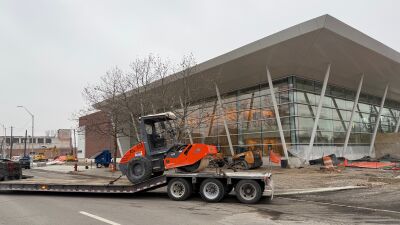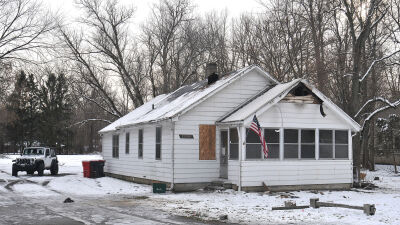
These photos show the before and after of emergency repairs undertaken on a section of seawall south of Pier Park in Grosse Pointe Farms. More than a dozen sections of badly deteriorated seawall in the Farms and Grosse Pointe Shores are being shored up this year with state funding.
Photo provided by Grosse Pointe Farms
GROSSE POINTE FARMS/SHORES — Emergency repairs to some of the most deteriorated sections of the Lake St. Clair seawall in Grosse Pointe Farms and Shores are underway.
Farms City Manager Shane Reeside said work on this first phase of seawall repairs started Aug. 16 and will be completed this fall.
The work is being entirely paid for with state dollars, so there’s no cost to the cities. Earlier this summer, the Farms was awarded a $750,000 grant from the Michigan Economic Development Corporation for this project.
“It’s county infrastructure, not city infrastructure,” Reeside said.
Because the seawall was originally built by Wayne County and is adjacent to a county road — Lake Shore Road — the cities have long maintained that seawall repairs and maintenance fall to the county, not the cities.
The seawall sections in most urgent need of repair were identified by engineers with Hubbell, Roth & Clark Inc. This first phase of repairs was initially slated to address an estimated 14 sections of seawall.
“The county has reduced some of the costs for this project by providing backfill aggregate,” Reeside said.
As a result, he said they hope to be able to add a few additional locations to the repair schedule this fall.
“The focus this (fall) was to address those areas that were the most jeopardized — either the road or the (underlying) infrastructure,” Reeside said.
One of the concerns Farms and Shores officials have voiced is that the crumbling seawall was likely undermining the roadway and could lead to a sinkhole, damage to water or sewer lines under Lake Shore Road, or both.
Record high water levels in Lake St. Clair in 2019 only exacerbated seawall deterioration. Although water levels have gone down about 2 feet since 2019, Reeside said there are still “extensive breaches” in the seawall and voids — or empty spaces — in the revetment behind the seawall.
Work crews are using a multistep process to tackle the emergency repairs. Reeside said they crush existing failed concrete seawall slabs to use as base material. Next, he said they install a half-inch-thick steel plate on the road side of the breached seawall sections. Reeside said workers then backfill the voids with aggregate, which is essentially stone. Finally, he said they pour new 8-inch-thick concrete revetment slabs reinforced with wire mesh.
During an Aug. 16 Grosse Pointe Shores City Council meeting, Shores Mayor Ted Kedzierski said that he, Shores City Manager Stephen Poloni, Reeside and Farms Mayor Louis Theros met with Wayne County Executive Warren Evans and his team at the end of July. Kedzierski said Evans acknowledged that this was a pressing matter.
“He was concerned about the plight of the seawall,” Kedzierski said.
As part of their discussions in July, Poloni said, they sought the county’s support in the grant-seeking process.
“They have a lot more pull than we do,” Poloni said.
Phase 2 of seawall work will start in spring 2023 using a $1.2 million grant from the state, Reeside said.
“The cities are working with Wayne County and our engineers on the scope of the work for next year and how to best leverage the state funding to secure additional federal funding,” Reeside said.
In 2019, HRC — engaged via an intergovernmental agreement with the Farms, Shores and Wayne County — assessed the seawall by doing soil borings and a topographical survey. HRC determined that it would cost roughly $23.8 million to replace the seawall. That’s more than the county, or the county working with the cities, could afford, which is why they’re hoping to obtain federal as well as state funding.
The cities acknowledge that local representatives in Lansing have played a key role in securing state dollars for this project. Reeside said the local communities are “very grateful” for the assistance they’ve gotten.
 Publication select ▼
Publication select ▼


























